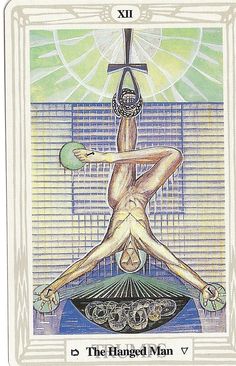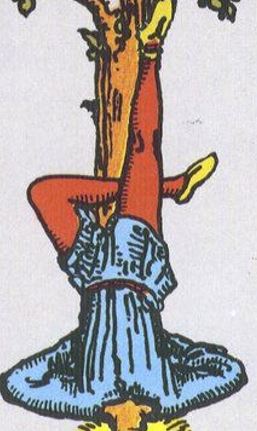Tarot Deep Dive - The Hanged Man
- Dustin
- Jul 17, 2022
- 6 min read
Updated: Aug 20, 2022
Every card represents an aspect of humanity that has echoed through time. In this series we are going to dive into the history of the imagery found within the tarot, the meaning of the cards and how that meaning changed over time, and the symbols present within the images of what is arguably the most well known tarot deck of all time - the Rider-Waite (Smith) Tarot Deck. So grab your favorite RWS deck, a cup of tea or coffee, and join me live on Sunday mornings over on YouTube as we Deep Dive into each one of the 21 Major Arcana cards continuing now with one of what is typically the most traditionally depicted cards; The Hanged Man.
The Hanged Man, Le Pendu, The Traitor, The Sacrifice, The Spirit of the Mighty Waters

The image of the Hanged man is one of the few pictorial tropes within the Major Arcana that has changed the least over the years. The card references a specific type of image that was used as significant form of social punishment during the renaissance in Italy, a Pittura Infamante or 'painting of infamy'.
Subjects for these public art works often included traitors, thieves, individuals who committed fraud, adultery, or even bankruptcy. They were often commissioned when no actual legal action could be taken against the individual because of lack of evidence or the criminal for that matter. But they also served another purpose, that of political propaganda and social punishment, and can almost be thought of a precursor to today's political cartoons.
These works were displayed in public spaces such as prisons or public forums. Interestingly these fresco works often depicted only men and never women to our understanding. No record, exemplar, or sketches of a women in a pittura infamante exists. These works were commonly found throughout Italy and few examples exist outside thereof.

These images were a little more stark than the one we typically find within the Tarot of a man being hung upside down by the ankle, a common punishment of the period for traitors in particular. Researcher Timothy Betts finds reference to this in a 1393 decree for Milan and Lombardy of the punishment for traitors: "Let him be drug on a plank at a horse’s tail to the place of execution, and there be suspended by one foot to the gallows, and be left there until he is dead. As long as he lives let him be given food and drink." A rather stark outcome in comparison to the blissful enlightenment we see depicted in the Tarot of today. Interestingly, these works only stopped being produced when the public ceased seeing them as public humiliation pieces and started viewing them as actual artistic works. However the image on the card has stayed true to the traditional art of pittura infamante, a key artistic expression during the birth of the Tarot in Italy, and a likely case for why it made it's way into the Major Arcana.
Visual Evolution
This card in particular is probably the one card to have had the least change to it over the hundreds of years Tarot as we know it today has existed. From the early Italian decks such as the Visconti Sforza we see the very traditional depiction of a pittura infamante. This tradition continues on through the french decks, and even Papus stays true to this approach, true to his form of egpytianizing the figure placing him in a loincloth that alludes to the knot of Isis or Tyet, a symbol reminiscent of the Ankh which we see appear in Crowley's rendition. The Goldendawn and the Smith-Waite interpretation stays true to the traditional composition as well, decidedly only adding a halo around the head of the figure and changing the traditional gallows into more of a cross, alluding to the christian visual tradition of martyrs and Christ. Additionally, in the Crowley-Harris take on this composition we see even more direct references to crucifixion with the inclusion of stakes through the hands and foot of the figure on the card, along side the smattering of other deeply esoteric symbolism they cram into their images.
We do, however, have some historical rebels, namely the Etellia and the Charles the IV. In the Charles the IV (or Estensi) deck we see a similar image however The Hanged Man holds two sacks of money in his hands. More interestingly, in the Etellia we see a depiction of the final of the four cardinal virtues - Prudence: "the ability to discern the appropriate course of action to be taken in a given situation at the appropriate time, with consideration of potential consequences.
Evolution of Meaning
De Mellet (1781): The Hanged Man. Prudence.
Levi (1855): The Hewbrew letter Lamed, a man hanging by one foot. Example, instruction, public teaching.
Mathers (1888): The Hanged Man. Self-sacrifice, sacrifice, devotion, that which is bound.
Golden Dawn (1896): The Spirit of the Mighty Waters. Hanged Man or Drowned Man. Enforced sacrifice, punishment, loss, suffering.
Waite (1910): The Hanged Man. Wisdom, circumspection, discernment, trials, sacrifice, intuition, divination, prophecy.
Crowley (1944): This card is beautiful in a strange, immemorial, moribund manner. It is the card of the Dying God; its importance in the present pack is merely that of the Cenotaph. It says: "If ever things get bad like that again, in the new Dark Ages which appear to threaten, this is the way to put things right." But if things have to be put right, it shows that they are very wrong. It should be the chiefest aim of the wise to rid mankind of the insolence of self-sacrifice, of the calamity of chastity; faith must be slain by certainty, and chastity by ecstasy.
The Symbols

Before delving into the specifics of the symbolism within the Smith-Waite depiction of The Hanged man I first wanted to touch on a occult/mythological reference often associated with this card. Many people draw a correlation between this card and the legend of Odin sacrificing himself and hanging himself off Yggdrasil for nine days and nine nights in order to gain occult knowledge and understand the runes or that of Merlin and his shamanic rite of passage while hanging upside down from a tree. Though we can see the allegorical correlation to the modern interpretation of the card, this correlation likely stems from more modern occultists imprinting these legends and allegory. There is no art historical reference that can be drawn to this card outside of the aforementioned above. Though these occult allegories and correlations have certainly played an important part of the interpretation of this card in modern decks such as the Waite-Smith and Crowley-Harris.

Gallows & Tau Cross
The gallows take a literally reference here to the ancient symbol of the tree of sacrifice, adorned with ivy. Unique to the Waite Smith the gallows take on the form of the Tau cross a symbol long representative of salvation and eternal life - a direct link and reference back to the Ankh. Waite himself says its a combination of Tau cross and a Fylfot cross.

Halo or Sun shape
According to Waite: "it surrounds the head of the seeming martyr." A traditional symbol used throughout christian art that can trace its etymology back to ancient Egypt and the sun disc of Ra, this represents divine awakening, enlightenment, and wisdom. His stoic face tells us that unlike a martyr who suffered for their beliefs , this sacrifice was free of suffering, or as Waite puts it: "the face expresses deep entrancement, not suffering.
Body in the shape of sulfur
Waite says in Pictorial Key "he who can understand that the story of his higher nature is embedded in the symbolism will receive intimations concerning a great awakening." A keen observer may notice that the body of The Hanged man is reminiscent of that of the alchemical symbol of sulfur from the great work or Magnum Opus. A discussion for another day perhaps.
As always be sure to check out our live discussion on this very topic over on YouTube:
References
Butler, B. Dictionary of the Tarot. New York: Schocken Books, 1986.
Chang, T. Susan. Tarot Correspondences: Ancient Secrets for Everyday Readers. Llewellyn Pulbications, 2018.
Crowley, Aleister (aleister Crowley). Book of Thoth - (Egyptian Tarot). Red Wheel/Weiser, 2017.
Dean, Liz. The Ultimate Guide to Tarot: a Beginners Guide to the Cards, Spreads, and Revealing the Mystery of the Tarot. Fair Winds Press, 2015.
Decker, Ronald; Dummett, Michael. A History of the Occult Tarot. London: Duckworth, 2019.
Fiebig, Johannes, and Evelin Burger. The Ultimate Guide to the Rider Waite Tarot. Llewellyn, 2013.
Katz, Marcus. Secrets of the Waite-Smith Tarot: the True Story of the Worlds Most Popular Tarot: with Previously Unseen Photography & Text from Waite & Smith. Llewellyn Publications, 2015.
Place, R. M. The fool's journey: The history, art, & symbolism of the tarot. York, 2010.
Waite, A. E. Pictorial Key to the Tarot. Dover Publications Inc, 2005.
Wen, Benebell. Holistic Tarot. North Atlantic Books, 2015.
http://pre-gebelin.blogspot.com/2013/07/a-modern-catholic-looks-at-tarot.html






















